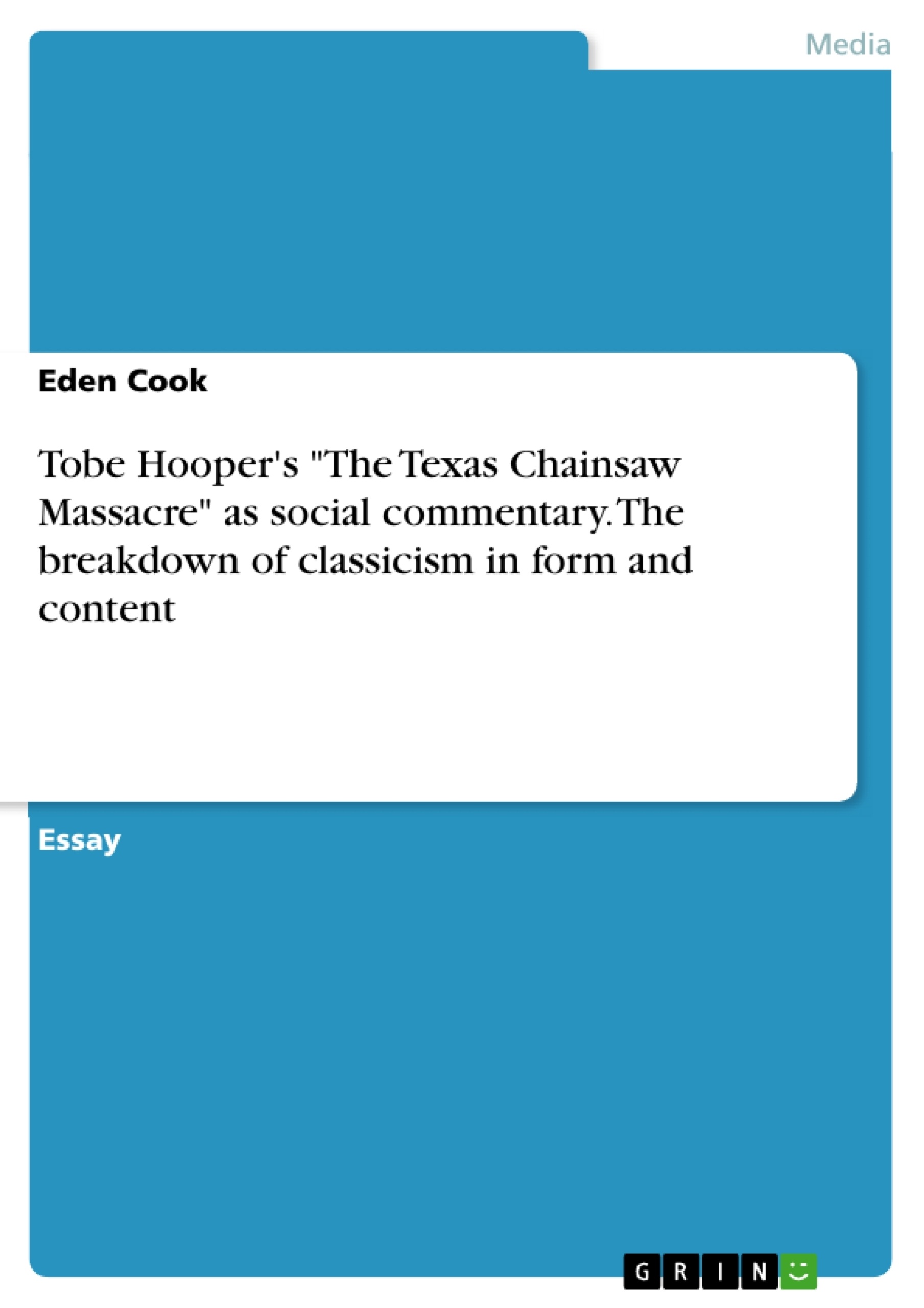This essay examines Tobe Hooper's "The Texas Chainsaw Massacre" as a form of social commentary with special attention to the breakdown of classicism in its form and content.
The 60's for film is marked as a breakdown of classicism in "formal innovation and narrative exploration" (Slocum), creating a new style of cinema seen across mainstream Hollywood. The Texas Chainsaw Massacre subverts from traditional modes of filmmaking with its use of extreme close-ups and vast distance, which creates a visually confusing experience.
Towards the end of the film as Sally is captured by the murderous family, her terror is presented by various extreme close-ups. Sally is tied to the dining chair as the family mock her distress, prolonging the imminent attack. The camera alternates between cuts of Sally’s face in extreme close-up as she screams, and shots of the family’s laughing faces. Rapid cuts show various sections of Sally’s sweating face.
At this point it is unclear as to whether the camera is mobile or whether the movement is from Sally. However, the mobility in the shot and closeness of the camera creates a visually confusing sequence as we see portions of Sally’s face from various angles, intensifying her horror. The chaotic, intrusive shot style magnifies the actresses’ performance, emphasising the intensity of her screaming.
Jarring notes accompanied by the sound of pigs squealing, echoes her sense of panic, whilst likening her to a distressed animal. We then get an extreme close-up showing only Sally’s eyeball which is wide with horror. The intrusive camerawork both obscures the audiences’ view and presents great detail. The intense shooting style attacks the viewer with extreme, repetitive shots accompanied by the jarring soundtrack creating a chilling experience.
Inhaltsverzeichnis (Table of Contents)
- The Texas Chainsaw Massacre and the Breakdown of Classicism
- The Use of Camerawork in The Texas Chainsaw Massacre
- Extreme Close-Ups
- Remote Long Shots
- Social Commentary and the Breakdown of American Values
- The Use of Mise-en-scene
- Subversion of Traditional Horror Formula
Zielsetzung und Themenschwerpunkte (Objectives and Key Themes)
This essay explores the ways in which The Texas Chainsaw Massacre (1974) subverts from traditional narrative cinema, focusing on the film's use of camerawork and its representation of social issues in America during the 1960s and 1970s.
- The subversion of traditional narrative cinema through camerawork and narrative structure.
- The film's reflection of social and political unrest in America during the 1960s and 1970s.
- The use of violence and cannibalism as a commentary on American values.
- The use of mise-en-scene to create a sense of disorder and madness.
- The subversion of traditional horror formula through extended scenes of distress and violence.
Zusammenfassung der Kapitel (Chapter Summaries)
The first chapter examines the breakdown of classicism in cinema during the 1960s, highlighting the emergence of a new style of filmmaking that challenged traditional narrative conventions. The second chapter analyzes the film's distinctive use of camerawork, exploring how extreme close-ups and remote long shots create a visually confusing and disorienting experience for the viewer.
The third chapter delves into the film's social commentary, examining how the themes of cannibalism and violence reflect the social and political unrest in America during the 1960s and 1970s. The fourth chapter analyzes the film's use of mise-en-scene, highlighting how the gruesome interior of the murder house creates a sense of disorder and madness that mirrors the social and political climate of the time.
The final chapter focuses on the film's subversion of traditional horror formula. It explores how the extended scenes of distress and violence challenge the traditional build-up of tension, shock, and release, creating a more intense and disturbing viewing experience.
Schlüsselwörter (Keywords)
The Texas Chainsaw Massacre, classicism, camerawork, extreme close-ups, remote long shots, social commentary, American values, violence, cannibalism, mise-en-scene, horror formula, subversion, 1960s, 1970s.
- Quote paper
- Eden Cook (Author), 2016, Tobe Hooper's "The Texas Chainsaw Massacre" as social commentary. The breakdown of classicism in form and content, Munich, GRIN Verlag, https://www.grin.com/document/323415




